If you are just getting into coffee brewing you may be looking to learn about the different ways to make coffee. Or you may already have a couple favorite coffee brewers and are looking to try something different. Whatever the case, if you are looking to learn about the different coffee brewing methods this article is for you.
There are many coffee brewing methods and in this article we will talk about 15 of the most popular ones. We can classify these brewing methods in 3 categories based on the mechanism they use: full-immersion, pour-over and pressure methods.
Full-immersion methods
Like the name suggests, immersion brewing methods require the coffee grounds to be immersed in water for a certain amount of time. Generally, these immersion brewers are easier to use than pour-over brewers which makes them ideal for beginners. You can expect immersion coffee to have a stronger and fuller flavor.
1. The French Press
The French Press is one of the most popular home brewing methods. Almost everyone getting into coffee making owns one. They are cheap, easy to use and can make a richer cup of coffee compared to pour over methods. The metal filter in the French Press lets through more of the non-soluble particles from the grounds into the coffee cup. This means that some of the oil from the coffee beans gets into the cup giving the coffee a rich texture. Yet, some people dislike French Press coffee because of its particular texture.
- Recommended ratio: 1:12 – 1:15
- Recommended grind size: medium coarse
- Brewing time: 4 minutes
- Pros: Inexpensive, no filter required, richer texture compared to pour-over methods. You can make multiple cups at a time. Does not need your full attention during the brewing process (you can make breakfast while waiting for the coffee to be ready)
- Cons: You may dislike the sludge (particles at the bottom of the cup). The coffee may turn out very bitter if you let it steep for too long.

To learn more about this brewing method, check our guide on French Press brewing.
2. SoftBrew
The SoftBrew is a relatively new invention having been introduced in 2010. At first glance it looks like a teapot. The way it works is similar to the French Press but without the plunger. Simply, add the coffee grounds and the hot water, let it steep for 4 minutes and then serve. There is a special filter inside the brewer that will make sure you get a clean cup of coffee.
- Recommended ratio: 1:16 – 1:17
- Recommended grind size: coarse
- Brewing time: 4 minutes
- Pros: Very easy to use. Cool design and comes in many colors
- Cons: More expensive than the French Press

3. Aeropress
The Aeropress is a plastic device consisting of 3 pieces. There is an upper chamber where the grounds are steeped, a piston to press the coffee grounds and a lower chamber that collects the brewed coffee. Even though we are classifying the Aeropress as an immersion method, this device uses a hybrid brewing method. First, the coffee grounds are immersed in water in the upper chamber. Then, a piston presses down on the coffee grounds to obtain the cup of coffee in the lower chamber. This resembles the espresso brewing process but with a lot less pressure.
- Recommended ratio: 1:10 – 1:16
- Recommended grind size: medium-fine. Although, this method should work with different grind sizes.
- Brewing time: 1-2 minutes
- Pros: Inexpensive, fast brewing time and very portable. It is especially popular among campers.
- Cons: Needs a special paper filter. Only produces one cup of coffee.

4. Syphon brewer
The syphon brewer is a really fun and flashy way to brew coffee. It looks more like a science experiment than coffee brewing. Although in a way coffee is all about science. The equipment is fairly expensive and fragile and it can take some time to get the process right. It is not a method we recommend for beginners. The siphon brewer has two chambers. The lower chamber is filled with water and heated to boiling point. The coffee grounds are placed in the upper chamber. Due to the heat generated, the water is pushed from the lower chamber through a tube and into the upper chamber. The coffee is steeped for 90-100 seconds. After that, the syphon brewer is removed from the heat source. As the brewer cools down, the device creates a vacuum effect that sucks the coffee from the upper chamber into the bottom chamber. This is our final cup of coffee.
- Recommended ratio: 1:15 – 1:16
- Recommended grind size: medium
- Brewing time: about 4 minutes
- Pros: Really impressive process, use it to showcase your brewing skills to your friends.
- Cons: Difficult to brew. Equipment is fragile and hard to clean.

5. Percolator
The percolator has been around for more than 200 years. It was the old way of making coffee before they were replaced by the drip coffee makers. You will often hear that percolator coffee just does not taste good. The problem with the percolator is that it can produce a cup of coffee that is too bitter and too hot to enjoy. This is because the water can get too hot leading to over-extraction. There is no reason to use a percolator now that we have so many other coffee brewer options that make better tasting coffee and can make it faster. Some percolator advocates just like the idea of using old technology.
- Recommended ratio: 1:15 – 1:16
- Recommended grind size: coarse
- Brewing time: 7-10 minutes
- Pros: No pros unless you like the nostalgia of using old technology
- Cons: Brews bad tasting coffee – too hot and bitter

6. Cowboy coffee
This is a very simple and old-fashioned way of making coffee. You do not need any kind of special equipment. To make Cowboy coffee, simply boil some water in a pot or kettle and then add the coffee grounds to the boiling water. Remove the pot from the heat source and let the coffee grounds brew for a few minutes. After the grounds have settled in the bottom of the pot, pour the coffee into your coffee mug. As you can see this process can be done in your kitchen or at a campsite. No fancy equipment is needed. Unfortunately, you won’t get the best flavor out of your coffee with this method. But, at least it will be better than instant coffee.
- Recommended ratio: 4 tablespoons of coffee (about 17.5g) for 1 liter of water
- Recommended grind size: medium coarse
- Brewing time: 10 minutes
- Pros: No need for special equipment.
- Cons: Not the best flavor. It can be very bitter.
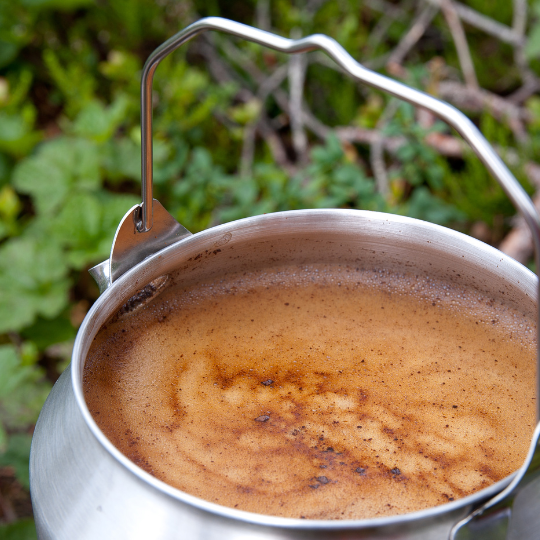
7. Turkish coffee
Turkish coffee is made using very fine coffee grounds (even finer than espresso) and a long-handled pot called a “cezve”. The coffee grounds are mixed with water (and sometimes sugar) and boiled until the mixture gets a frothy texture. Then, the coffee is poured into cups without using any filtering method. This means that the very fine coffee grounds will end up in the coffee cup. Leaving the coffee unfiltered results in a higher caffeine content and a stronger flavor.
- Recommended ratio: 7g of coffee for 70g of water. But you can experiment with different ratios depending on how strong you like your coffee.
- Recommended grind size: very fine
- Brewing time: 3-4 minutes
- Pros: Unique strong flavor, high caffeine content.
- Cons: Some people really dislike having the coffee grounds in the coffee cup even if they are extra fine. Requires special equipment for both grinding and brewing.

Pour-over methods
Pour-over methods are very popular among coffee enthusiasts. In this brewing method, you need to pour water over ground coffee beans that are sitting on a filter. Generally, you will get a cleaner cup of coffee by using a pour-over device vs. the coffee you would get with an immersion brewer. There are a couple of terms that you will hear when someone is talking about pour-over coffee brewing: bloom and drawdown.
Bloom: Initial part of the pour-over brewing process in which we wet the coffee grounds to allow the release of the gasses in the grounds.
Drawdown: The process of liquid filtering through the coffee into the cup below.
.
8. Chemex
The Chemex has been around since 1941 and it remains one of the most popular pour-over devices. If you like pour-over coffee and want to be able to make multiple cups at a time, then the Chemex is perfect for you. The Chemex has a simple but elegant design. The Chemex is a glass flask in an hourglass shape. The funnel section on top holds a paper filter and the bottom section serves as a carafe. The Chemex uses special paper filters that are thicker than others. The thick paper filter will create a cleaner cup of coffee. That being said, the Chemex is not the most forgiving brewing method (although, it is still easier to use than the V60). You need to use the right grind size, water temperature and perfect the pouring technique to get a nice cup of coffee.
- Recommended ratio: 1:15 – 1:17
- Recommended grind size: medium coarse
- Brewing time: around 4.5 minutes (including bloom for about 30 seconds)
- Pros: Can brew multiple cups at once. Elegant design.
- Cons: You need to practice your brewing skills to get a perfect cup of coffee.
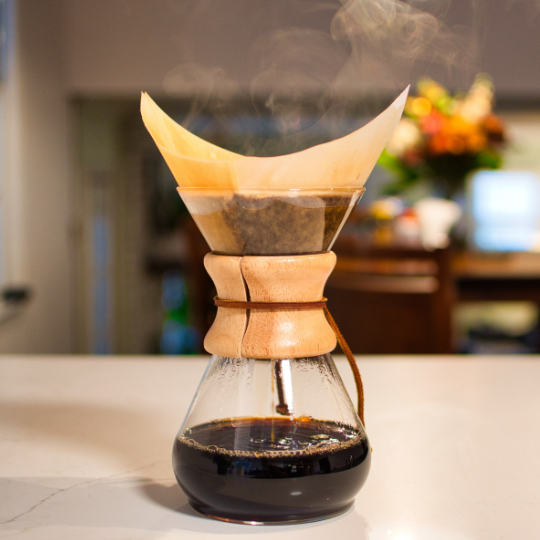
9. Hario V60
The V60 is a relatively new innovation having been created in 2004. It looks small and boring compared to other pour-over designs. But do not let its appearance fool you. This brewing device has a unique cone shaped design with a large hole at the bottom funneled by spiral ribs on the side. These ribs on the sides improve the airflow during the brewing process leading to a faster and more balanced extraction. The V60 is a device that really lets you customize and improve each part of the brewing process. It requires some practice to perfect the technique but once you get the hold of it you can get one of the best cups of coffee with this brewer. However, it only lets you brew one cup at a time so it may not be the best device to use when you are hosting a brunch.
- Recommended ratio: 1:15 – 1:17
- Recommended grind size: medium fine
- Brewing time: around 3.5 minutes (including bloom for about 45 seconds)
- Pros: Very portable, inexpensive.
- Cons: Requires your attention during the entire brewing process. Takes time to perfect the technique.

10. Clever Dripper
Even though we have included the Clever Dripper in the list of pour-over devices, it is actually a hybrid between a pour-over and a steeping brewer. The Clever Dripper is a cone shaped device with a filter, like other pour-over devices. But, it has a valve at the bottom that stops the brewed coffee from draining until activated. To drain the coffee, you just have to press the Clever Dripper onto your cup and the device will start to pour the coffee. This is a really fun way to serve coffee. The Clever Dripper is easier to use than the Chemex or V60 so it is a good brewing method for beginners. It is in a way the best of both worlds: easy to use like the French Press but you also get a cleaner cup thanks to the paper filter.
- Recommended ratio: 1:15 – 1:18
- Recommended grind size: medium-coarse
- Brewing time: Up to personal preference, let steep for 2-4 minutes
- Pros: Easy and fun to use, inexpensive. Perfect if you are looking to brew a single serving.
- Cons: Only brews one cup at once

11. Kalita Wave
The Kalita Wave is usually compared to the Hario V60 as they are similar in size and design. But, the Kalita has a reputation for producing a more consistent brew which makes it popular among beginners. What makes the Kalita Wave different to other pour-over brewer is its particular design. It features a flat bottom and 3 small holes that restrict the flow of coffee. The Kalita also requires a special paper filter with a similar flat bottom instead of the more popular conic shape. This brewer comes in different materials but the stainless steel one is the most popular version. It also is available in a single serving size and a bigger version that can brew up to 4 cups.
- Recommended ratio: 1:15 – 1:17
- Recommended grind size: medium
- Brewing time: around 3.5 minutes (including bloom for about 30 seconds)
- Pros: Good for beginners. Comes in a variety of materials and sizes
- Cons: Needs a special filter
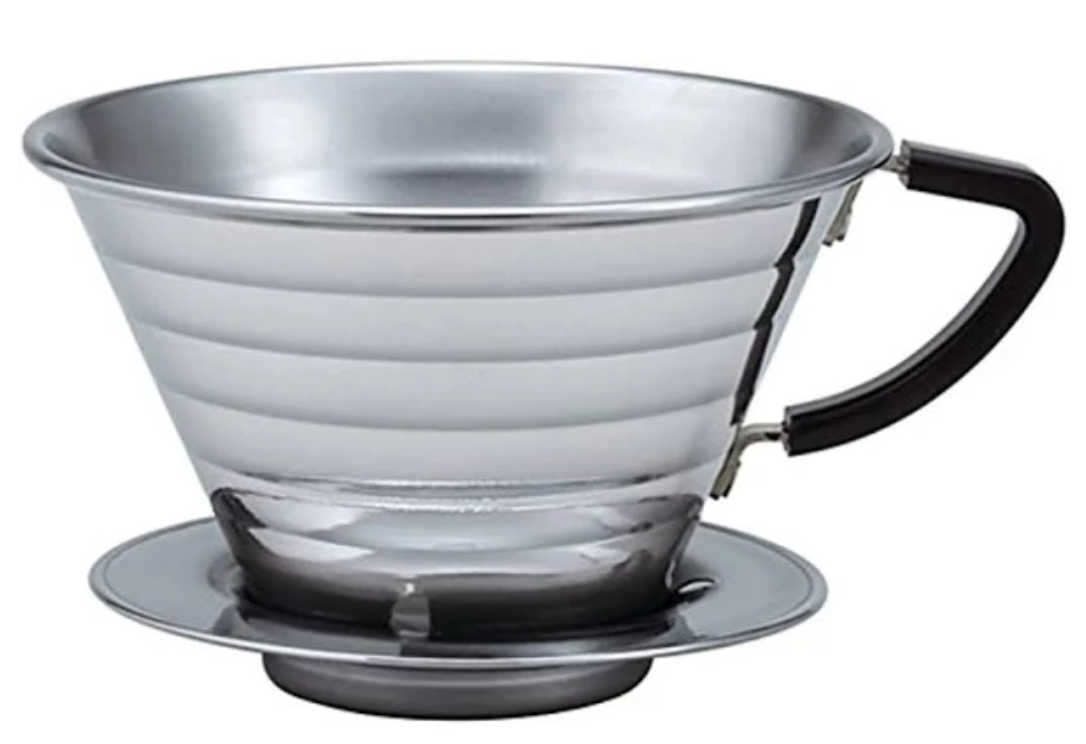
12. Bee House
As all pour-over devices, the BeeHouse requires more technique than immersion devices. However, it is one of the most forgiving pour-over devices. You will get a pretty good cup of coffee even if you are just a beginner to the coffee brewing game. It also has a really cool design, it’s made of ceramic and comes in different colors so it will look good in your kitchen. The BeeHouse has 2 drain holes which restrict the water flow making it less dependent on a good pouring technique. The grind size is the main factor that will determine the flow rate.
- Recommended ratio: 1:15 – 1:17
- Recommended grind size: medium fine. Experiment with different grind sizes to change the flow rate.
- Brewing time: around 3.5 minutes (including bloom for about 30 seconds)
- Pros: Very forgiving, less emphasis on pouring technique. No need for special filters, compatible with standard Melitta filters.
- Cons: Only available in ceramic which can be pretty fragile.

13. Electric filter machine
Using an electric machine saves you a lot of work during the brewing process and allows for more consistency. However, most electric machines cannot make very good coffee. This is mainly because the machine is not able to get the water to the right brewing temperature. If you are using one of these machines or thinking about getting one, note that they tend to work better when brewing larger volumes of coffee.
- Recommended ratio: 1:15 – 1:17
- Recommended grind size: medium
- Brewing time: 6-12 minutes
- Pros: Easy to use, automated. You can brew several cups at once.
- Cons: Does not produce the best coffee specially if trying to brew small volume.
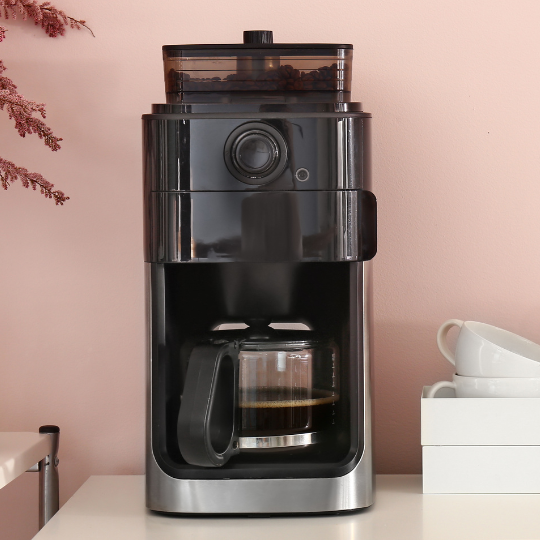
Pressure methods
There are only 2 brewing methods that use pressure as the main mechanism: the moka pot and the espresso machine. These methods require special equipment and are known for making great coffee.
14. Moka pot
Are you looking for a coffee similar to espresso but you do not want to spend hundreds of dollars on an espresso machine yet? Then, the Moka Pot can be a great option for you. They come in multiple sizes from 1 cup to 12. Similar to the espresso machine, this device uses pressure to brew coffee. The Moka Pot consists of 3 chambers. The water in the bottom chamber boils, and the steam generates pressure. This pressure pushes water up through the coffee grounds into the top chamber. The main challenge with using a Moka Pot is that the water can get too hot resulting in a very bitter cup of coffee. To avoid this, you need to carefully watch the brewing process and remove the pot from the heat source in time.
- Recommended ratio: 1:7 – 1:12
- Recommended grind size: fine
- Brewing time: 3-4 minutes
- Pros: Easy to use, comes in multiple sizes. Produces rich coffee similar to espresso
- Cons: Can produce very bitter coffee. Difficult to clean.

15. Espresso machine
Espresso is one of the most popular ways to brew coffee and many people’s favorite. Compared to all other brewing devices, the espresso machine is without doubt the most expensive. It also requires frequent cleaning and descaling to avoid impacting the quality of the coffee. The espresso machine brews coffee by forcing pressurized hot water through very fine coffee grounds. The extraction process only takes 30 seconds. There are espresso machines with different levels of automation. But, you should still understand the brewing process to properly calibrate your machine and make awesome coffee.
- Recommended ratio: 1:2 to 1:2.5
- Recommended grind size: fine
- Brewing time: 30 seconds
- Pros: Only way to make high quality espresso. Available with different levels of automation. Very short brewing time.
- Cons: Expensive. Requires frequent cleaning and descaling.
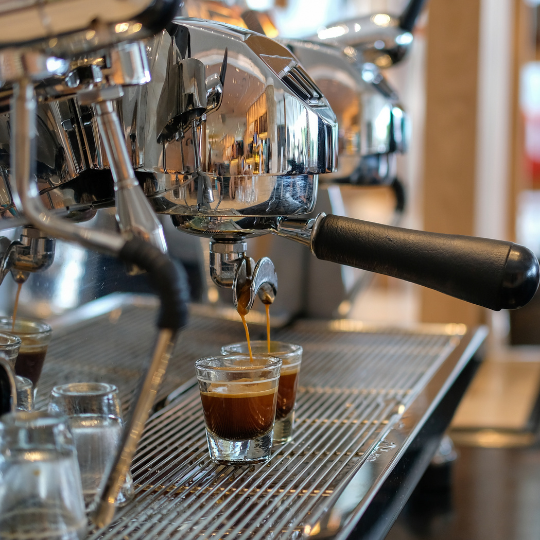
Brewing methods summary

So did you find a brewing method you want to try? As you can see there are quite a few. There are going to be some brewing methods that will be better for you depending on how much time and money you want to invest. If you are a beginner you may find immersion methods such as the French Press easier to use. If you are trying to step out your game and be more involved in the brewing process it may be time to start trying some pour over methods. Or, if you are looking for a more automated process and you are willing to make the investment, you could choose to get an espresso machine.
